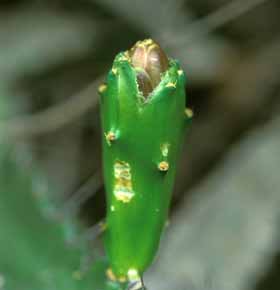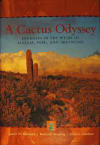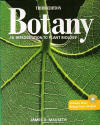|
Introduction

Epidermis

Cortex

Leaves

Spines

Poisons

Wood

Root Succulence

Apical Meristems

Cephalia

Flowers

Travel

Published papers
| |
Cactus Flowers
Cactus flower anatomy has received little attention. Flowers are large and showy
in many genera, with dozens of petals and stamens rather than just the 5 or 10
of each as we might expect of a dicot. All cacti, other than a few species in
Pereskia, have an inferior ovary, and that is the point of this portion of
the website. The ovaries of cacti are not merely inferior, they are
spectacularly inferior.
Although axillary buds produce flowers, they always produce a bit of stem tissue
first: the very first appendage primordia are leaf primordia, not sepal
primordia. In most cacti, the axillary bud apical meristem actually produces 20
or 30 or more leaf primordia before it actually switches over to producing
floral appendage primordia. The noteworthy thing is that these leaf primordia
typically develop much more than do other leaf primordia on the same plant, and
they mature into large scales that may be a centimeter or more long and have a
thin, flat lamina-like region. People typically do not realize that these cactus
leaves are true leaves but they are indeed. They are usually called “scales” or
“bracts” but that does not matter: they are leaves. The problem is that the
ovary is so deeply inferior that these leaves appear to be part of a flower
rather than part of a vegetative stem.
The confusing nature of the stem and flower is due to the following modified
development. The axillary bud apical meristem produces its series of leaf
primordia, then a typical series of sepal, petal, stamen and carpel primordia,
each above the other on the sides of the shoot apex as happens in any other
group of plants. But as these primordia begin to
enlarge and differentiate, peripheral shoot tissue below the leaf primordia
elongates more than the inner shoot tissue below the carpel primordia. Whereas
in ordinary stems all parts of the stem from pith to epidermis elongate exactly
the same amount, here the pith lags behind while the epidermis and outer cortex
extend, so the flower and subtending shoot
turn themselves inside out. Imagine partially inflating a cylindrical toy
balloon, then painting on dots to represent the leaf, sepal, petal, stamen and
carpel primordia. Once all dots have been painted on with carpel dots at the
closed end of the balloon, imagine placing your finger on the end of the balloon
then blowing it up further: the balloon will become a hollow cylinder with the
stamen dots on the inside next to your finger, the petal and sepal dots at the
end and the leaf dots on the outside.
In a cactus flower, the hollow tube has
leaves arranged in ordinary phyllotactic spirals on the outer surface almost
until the rim of the tube is reached, then there are sepals and petals at the
uppermost portions of the outside of the tube as well as at the rim, then down
the inside of the tube are the numerous stamens with the first-formed ones at
the top near the rim and the last-formed ones at the bottom of the tube’s
interior near the carpels. Consequently, when you look at a cactus flower bud,
you are not seeing any flower tissue at all except for the sepals and petals at
the very tip; all the rest is vegetative stem and leaf, and the true flower parts
are located inside. It is easier to comprehend that this really is vegetative
tissue by realizing that these leaves typically bear clusters of spines in their
axils. Need more proof? In Pereskia sacharosa and in Opuntia fulgida,
the axillary buds of the leaves can themselves produce flowers so there are
flowers borne on flowers. Opuntia fulgida can repeat this many so many
times that as the flowers each mature into fruits, there are fruits hanging from
fruits hanging from fruits…… the common name is “chain fruit cholla.” Because
the outer part of a cactus “flower” is really vegetative tissue, once this all
ripens into a fruit, the outer parts develop into a false fruit and the inner
parts – those derived from the carpels – constitute the true fruit (remember
that in apples, most of us only eat the false fruit and we throw away the true
fruit, the core).
I
have added this part to the website because the presence of leaves on the flower
buds brings up an important point: most cacti still have the genes necessary to
make large, flat, photosynthetic leaves. However, those genes are strictly
repressed in the ordinary succulent stems of cacti, even though many live in
areas that are moist enough that it would appear to be advantageous to have
leaves at least during the rainy season. It could be – and this is a wholly
unexplored hypothesis – that cacti are indeed making ephemeral leaves at exactly
the time that they need them: when ovules are maturing into seeds and carpels
are developing into fruits. The presence of leaves on the flowers may truly
boost photosynthesis exactly when and where an extra boost is needed. On the
other hand, in most cacti the extra amount of photosynthetic surface area
produced by the flower’s leaves seems inconsequential compared to the total
green surface area of the shoot, and their photosynthetic output seems trivial
compared to all the starch that could be stored in the stem throughout the year
as the evergreen stem photosynthesizes month after month.
A
confounding aspect is that in some genera, there are no leaves or scales on the
flowers, and these have been interpreted as having the same organization as
other cactus flowers, but with the vegetative part consisting of just a single
internode rather than many.
Another aspect
of extremely inferior ovaries in cacti: in Calymmanthium, the
vegetative tissues extend to the very rim of the tube as expected of cacti, but the rim itself does
not expand much during flower development. The rim remains a microscopically
narrow hole that is the same diameter as when it was formed by the floral apical
meristem whereas in all other cacti the rim grows along with the rest of the
flower, forming a wide rim that bears many petals (look at the flowers on the
top of this page). Because the rim does not widen during development, a Calymmanthium flower develops inside a pouch of vegetative
tissue -- when the flower is ready to open, it actually has to tear the
vegetative tissues apart before the petals can emerge.
 |
Flower of Calymmanthium fertile.
Whereas the petals of most cactus flowers begin to be inserted at the top
of the flower tube, the rim continues to be stem tissue in Calymmanthium.
Because all flower parts begin as microscopically small primordia, when
the tip of this tube was formed, it too was microscopically small -- and
it stayed that way. It did not grow into the large opening like that on
the flowers on the top of this page. Consequently, a Calymmanthium
flower grows very well protected inside a vegetative pouch, but when it
needs to open, it has to fight its way out -- the flower must actually rip
the pouch apart. Calymmanthiums are big, rambling bush-like cacti; we have
several at the University of Texas, but so far they have not yet become
large enough to bloom here. This specimen was provided by Dr. Jean-Marie
Solichon, Director of the the Jardin Exotique
in Monaco (the Jardin Exotique is a superb collection of cacti and
succulents and is well worth a visit). Click the photo for
a larger image. |
As
mentioned, the biological consequences of cacti having leaves and vegetative
tissues completely surrounding their flowers is an area that has not been
explored at all and would make a good project for someone.
I haven't done any research on flowers
yet, so for further reading in this area, I recommend my two books again,
Botany and A Cactus Odyssey.
[end Flowers page]

 |
